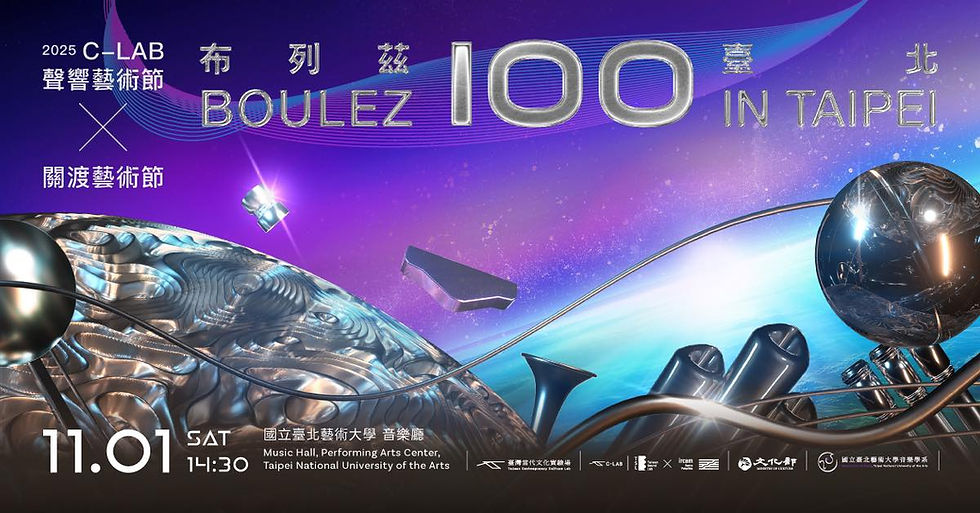《Boulez 100 in Taipei》Honoring a great French composer and conductor — experience the magic of modern music
- Yoyo Cello Web

- 5 days ago
- 4 min read
Do you remember when we talked about the evolution of the electric cello? We discussed the emergence of electronic instruments and the technological advances from the early to mid-20th century. Today, I’d like to introduce a special upcoming performance in Taipei — 'Boulez 100 in Taipei'. The concert commemorates Pierre Louis Joseph Boulez (1925–2016), one of the most important figures of that era.

He was a composer, conductor, and writer, as well as the founder of IRCAM (Institut de Recherche et Coordination Acoustique/Musique), one of France’s most important music research institutions. Boulez was also a leading figure in Western classical music after World War II. His deep passion for music, extraordinary creativity, and the historical context of his time — marked by the rise of electronic instruments and new sonic possibilities — all contributed to the birth and evolution of modern music.
With the support of the French government, the establishment of IRCAM in 1977 allowed Boulez to fully explore his true fascination — the instantaneous transformation of instrumental sound. Music critic Peter Heyworth once described his work Répons (1980–1984) as ‘as if a great window had been opened, through which a new world of sound entered — and with it, a new world of imagination. What is even more impressive is that there is no longer a division between the worlds of natural and electronic sound, but rather a continuous spectrum between them.
Beyond his exploration of electronic music and technology, even in later works where he abandoned electronic means, Boulez continued to experiment with the spatial placement of instruments on stage. This approach allowed him to recreate the harmonic resonance, timbral depth, and spatial echoes that he had once achieved through electronic techniques. The upcoming concert 'Boulez 100 in Taipei' will fully showcase this distinctive aspect of his music!
This concert is jointly presented by the Taiwan Sound Lab (C-LAB), Taipei National University of the Arts, and IRCAM. Through the interplay of contemporary electroacoustic technology and new music performance, it delves into the intricate relationship between the rational structures and auditory experiences in Boulez’s works, unfolding a profound dialogue between sound and space.
We warmly welcome everyone to join us in person and experience the performance live. You’ll truly feel the essence behind the words above, gain a deeper understanding of Boulez, and broaden your perspective on the world of music.

2025
Boulez 100 in Taipei
Performance Details:
Date & Time: Saturday, November 1, 2025, 14:30
Venue: Music Hall, Taipei National University of the Arts
Conductor: Mei-Fang Lin
Taipei National University of the Arts New Music Workshop:
Flute: Chih-Yueh Yang
Clarinet: Pei-Lun Tsai, Yu-Fang Chu
Percussion: Shu-Hsuan Wang
Violin: Ting-Yun Li, Pei-Shan Wang
Cello: YoYo Cello (Dengkai Wu), Wen-Chien Lin, Zhu-Jun Bai, Chia-Chen Hsieh, Yi-Wen Chen, Wei Huang, Yan-Ling Hsu
Piano: Yu-Chen Hsieh
Sound Engineering (IRCAM): Sylvain Cadars
Computer Music Design (IRCAM): Dionysios Papanikolaou
YoYo is also participating in this performance! We warmly invite everyone to join us and experience the enchanting musical world of Boulez together!
Today, we’d like to introduce one of the featured pieces in the performance: Messagesquisse (1976).
This work is a composition for seven cellos (one solo and six accompaniment) by Pierre Boulez, created between 1976 and 1977.
The piece was commissioned by cellist Mstislav Rostropovich to celebrate the 70th birthday of conductor Paul Sacher. In addition to Boulez, Rostropovich invited eleven other composers to write cello works in honor of this influential figure in the music world.
Rostropovich made a particularly ingenious request: each composer was asked to use the ‘Sacher motif’ principle in their composition, transforming the letters of Sacher’s name into musical pitches to create melodic motifs: E♭-A-C-B-E-D (Es = E♭ in German notation for S, H = B♮ in German, Re = D♮ in French).
At the time, Boulez offered the following explanation:
Avec ce mot-valise, j'ai voulu offrir un témoignage de mon amitié envers Paul Sacher : l'œuvre renferme des messages qui lui sont adressés personnellement et sont codés de façon symbolique, comme dans une esquisse.
“I wanted to use this hybrid word to express a personal statement about my friendship with Paul Sacher. This piece already contains personal information about him, and I have placed the corresponding encoding in my draft.”[Note 1]
Against this background, beyond the concept of encoding, the style of the piece truly reflects its title. The music unfolds from quiet to loud, slow to extremely fast, with layers upon layers, resembling signals being transmitted and intertwined. It narrates their worldview and story, making it a very interesting experiment.
From the video, it’s clear that this piece is full of difficulty and challenge. What unique sparks and performances will YoYo and the other cellists ignite on stage? We’ll have to wait and see.
— Written and introduced by NANA
[Note 1] Un entretien de Wolfgang Fink avec Pierre Boulez, livret du CD Deutsche Grammophon 2000, p. 34.







Comments